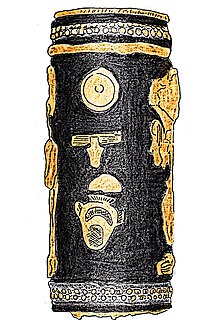Immeya
| Immeya | |
|---|---|
 Drawing of the mace handle with Hotepibre's name, gift for Immeya | |
| King of Ebla | |
| Reign | around 1750-1725 BCE |
| Successor | possibly Hammu[rabi] |
| Burial | "Tomb of the Lord of the Goats", in Ebla |
Immeyawas a king ofEbla,in modernSyria,reigning around 1750–1725 BCE.[1]: 217–8
Reign[edit]
Immeya was most likely buried in the so-called "Tomb of the Lord of the Goats", in the royalnecropolisof the western palace at Ebla,[1]: 301–4 as suggested by a silver cup found here, bearing an inscription in his name.[1]: 217–8 Assuming that, it is likely that the funerary equipment found in the tomb belonged to Immeya too. This included some objects in carvedhippopotamusivory,[1]: 301–4 the remains of a throne decorated with bronze goat heads,[1]: 338 and especially anancient Egyptianceremonial macemade of gold, silver and ivory, a gift from the13th DynastypharaohHotepibre,who was a contemporary of Immeya.[1]: 217–8 : 301–4
Immeya also appears as the sender of a letter to a ruler, which was also found at Ebla.[1]: 217–8 One of his successors—not necessarily the direct one—was a certain king Hammu[...], whose full name was probably Hammurabi.[1]: 217–8
As with other rulers of thethird kingdom of Ebla,Immeya's name isAmorite;furthermore, it seems that "Immeya" was ahypocorism.[1]: 217–8
